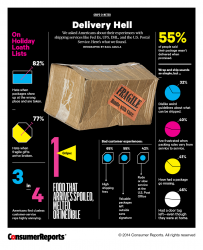
6 simple steps to ensure that holiday gifts arrives on time—and in one piece
When it comes to sending and receiving packages, all of us have plenty to grouse about. Damaged or late deliveries and snatched packages bug consumers the most, which covers Americans’ experiences with DHL, FedEx, UPS, and the U.S. Postal Service.
Some shipping mishaps are beyond your control, but you can take steps to make a gift’s road—or flight—less bumpy, whether you’re on the sending or receiving end:
 1. Time it right
1. Time it right
The sooner you place your order, the less susceptible it’ll be to delays from bad weather, higher-than-expected package volumes, items temporarily out of stocks, and other issues. Christmas falls on a Thursday this year. That means Monday Dec. 20 is the deadline for second-day delivery, and Tuesday Dec. 21 is the drop-dead date for (very expensive) next-day service. Standard ground shipping typically takes about three to five business days, but this time of year, it’s prudent to allow a few extra days.
2. Choose a sturdy container
Corrugated-cardboard boxes are best for heavy cargo such as small appliances or gift baskets. Mailing boxes, which fold up via a self-locking tab, are ideal for small, reasonably flat items such as books. (Weight limits are typically indicated on the bottom panel.) Whenever possible, use a new box—especially for heavy items—because reuse weakens the cardboard. If you do choose to reuse a box, inspect it for rigidity, tears, rips, or corner damage, and remove all labels and shipment information from its previous journey. Make sure it has all its flaps, too.
3. Pack for a hard landing
That video of a UPS driver caught kicking and tossing packages like footballs is extreme, but take its message to heart. Shroud breakable items in protective inner packaging and surround them with filler to ensure that the contents don’t move when you shake the box. Double- or triple-wrap sharp or protruding edges and bind them with tape. Add enough loose material in the box to fill the empty space, so the contents sit snugly. (Carriers recommend each item be surrounded by at least 2 two inches of cushioning placed at least 2 inches from the walls of the box to avoid product-against-product damage and protect against shock and vibration.)
4. Use the right wrap
Avoid packing breakables in clothing, sheets, towels, or newspaper. Most effective are sheets of air-filled plastic bubbles (aka Bubble Wrap), though those bags aren’t recommended for items with sharp corners. They also tend to be inadequate in very cold or very hot temperatures. Polystyrene peanuts and tightly crumpled paper (think supermarket or shopping bags) are good options too. Additional pieces of corrugated cardboard add rigidity, prevent products from shifting in transit and make excellent dividers. Be sure to ship perishables in a polystyrene cooler with dry ice or cold packs.
5. Seal with care
Use a waterproof marker to write the full address of both the sender and recipient on the outside of the package. Include a duplicate label or business card inside, so the carton can be returned if it gets damaged and becomes undeliverable. Tape the opening and secure all seams with at least 2 inches of reinforced clear or brown adhesive-backed packaging tape. Shippers recommend applying tape strips evenly across the flaps and seams on both top and bottom to make an “H” shape. Don’t wrap the box in paper, which could rip apart in transit, or twine, which can stick in conveyor belts and lead to damage as well.
6. Consider insurance
UPS and FedEx shipments automatically come with declared-value coverage of up to $100. The U.S. Postal Service provides similar coverage for Priority Mail Express shipments. Declared value is the carrier’s maximum liability. If the package is lost, damaged, or stolen, you’ll need to file a claim and can do so as early as 24 hours after expected delivery. (Timing differs by carrier.) Since the shipper is unlikely to take just your word, you’ll need backup: invoices, product sales and shipping receipts (including package tracking and delivery confirmation, which strengthen your claim), proof of insurance, and so forth. If the gift recipient spots damage, ask him or her to hold on to all packaging materials. Photos—before and after—help, too.